Data Protection Act 2018: A Study of Confidentiality and Data Storage
VerifiedAdded on 2023/06/10
|5
|1879
|457
Essay
AI Summary
This essay provides an analysis of the Data Protection Act 2018 in the United Kingdom, emphasizing its role in regulating the use of personal information by organizations, businesses, and the government. It elucidates the implementation of the General Data Protection Regulation (GDPR) through the Act, highlighting the stringent guidelines known as 'data protection principles' that ensure data is adequate, relevant, accurate, and securely managed. The essay also delves into the rights of individuals regarding their data, including the right to be informed, have data amended or destroyed, and object to data processing. Furthermore, it discusses data storage methods, differentiating between direct-attached storage (DAS) and network-attached storage (NAS), and addresses the critical issue of confidentiality in healthcare settings, underscoring its importance in fostering trust between patients and healthcare providers. The essay concludes that the Data Protection Act 2018 is crucial for safeguarding individual privacy and ensuring responsible data handling practices.
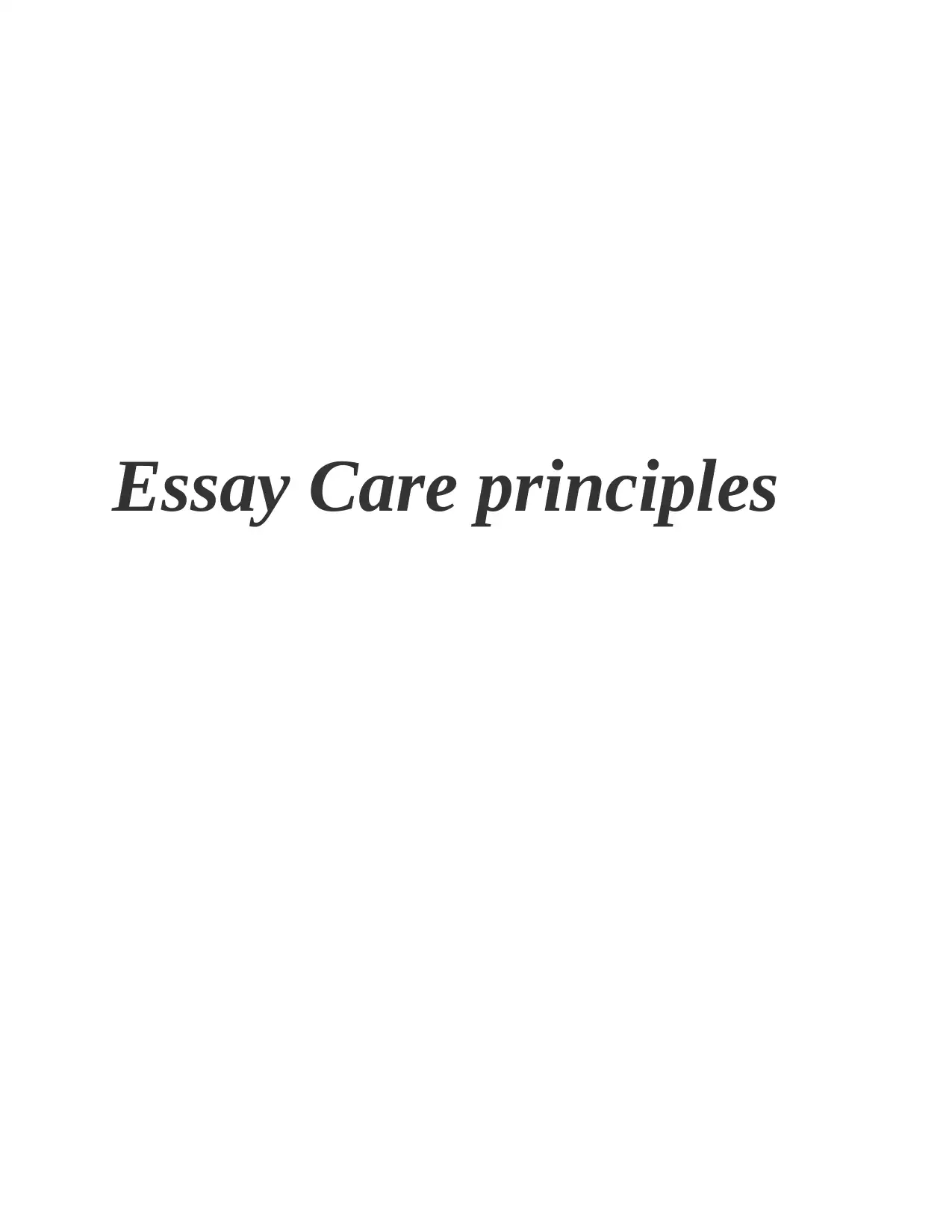
Essay Care principles
Paraphrase This Document
Need a fresh take? Get an instant paraphrase of this document with our AI Paraphraser
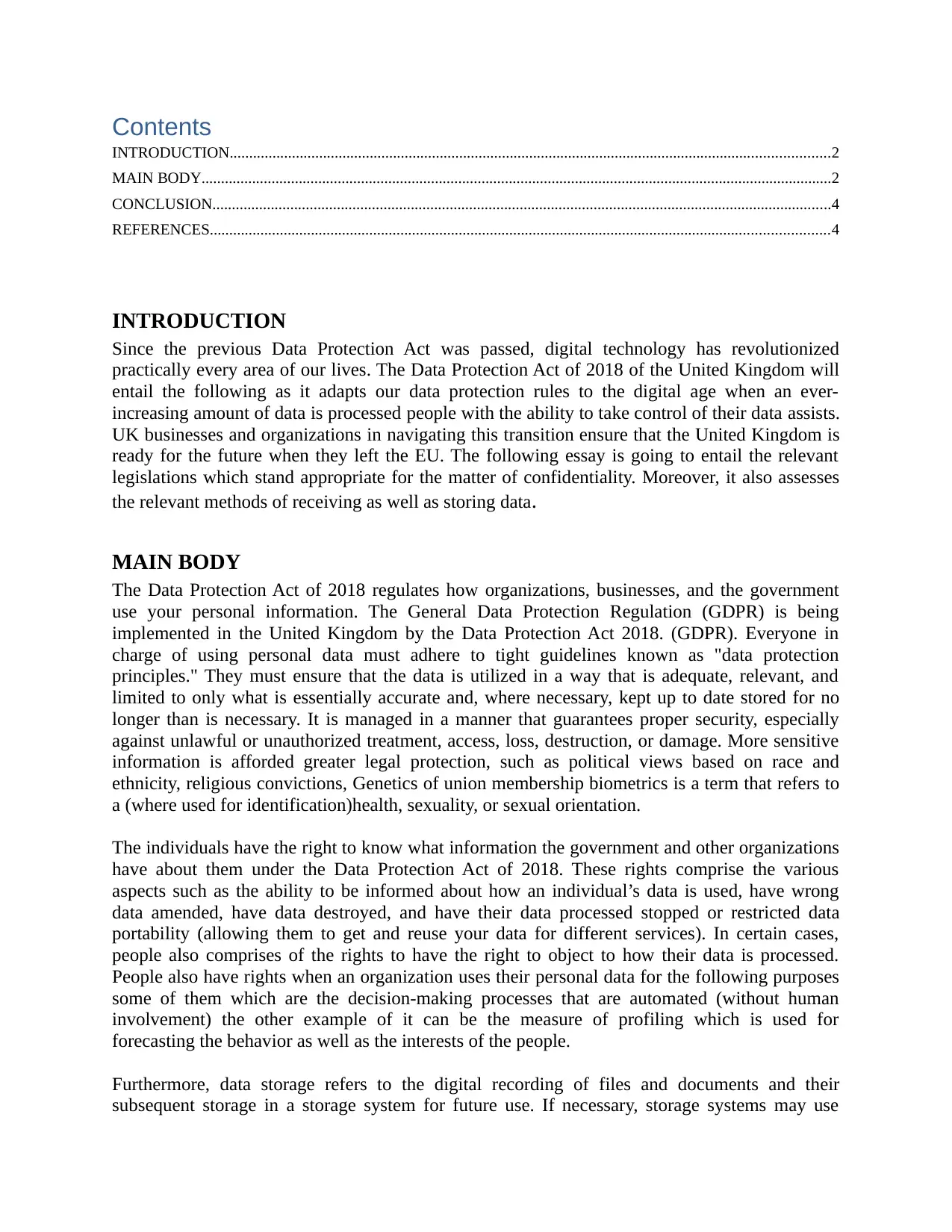
Contents
INTRODUCTION..........................................................................................................................................................2
MAIN BODY..................................................................................................................................................................2
CONCLUSION...............................................................................................................................................................4
REFERENCES...............................................................................................................................................................4
INTRODUCTION
Since the previous Data Protection Act was passed, digital technology has revolutionized
practically every area of our lives. The Data Protection Act of 2018 of the United Kingdom will
entail the following as it adapts our data protection rules to the digital age when an ever-
increasing amount of data is processed people with the ability to take control of their data assists.
UK businesses and organizations in navigating this transition ensure that the United Kingdom is
ready for the future when they left the EU. The following essay is going to entail the relevant
legislations which stand appropriate for the matter of confidentiality. Moreover, it also assesses
the relevant methods of receiving as well as storing data.
MAIN BODY
The Data Protection Act of 2018 regulates how organizations, businesses, and the government
use your personal information. The General Data Protection Regulation (GDPR) is being
implemented in the United Kingdom by the Data Protection Act 2018. (GDPR). Everyone in
charge of using personal data must adhere to tight guidelines known as "data protection
principles." They must ensure that the data is utilized in a way that is adequate, relevant, and
limited to only what is essentially accurate and, where necessary, kept up to date stored for no
longer than is necessary. It is managed in a manner that guarantees proper security, especially
against unlawful or unauthorized treatment, access, loss, destruction, or damage. More sensitive
information is afforded greater legal protection, such as political views based on race and
ethnicity, religious convictions, Genetics of union membership biometrics is a term that refers to
a (where used for identification)health, sexuality, or sexual orientation.
The individuals have the right to know what information the government and other organizations
have about them under the Data Protection Act of 2018. These rights comprise the various
aspects such as the ability to be informed about how an individual’s data is used, have wrong
data amended, have data destroyed, and have their data processed stopped or restricted data
portability (allowing them to get and reuse your data for different services). In certain cases,
people also comprises of the rights to have the right to object to how their data is processed.
People also have rights when an organization uses their personal data for the following purposes
some of them which are the decision-making processes that are automated (without human
involvement) the other example of it can be the measure of profiling which is used for
forecasting the behavior as well as the interests of the people.
Furthermore, data storage refers to the digital recording of files and documents and their
subsequent storage in a storage system for future use. If necessary, storage systems may use
INTRODUCTION..........................................................................................................................................................2
MAIN BODY..................................................................................................................................................................2
CONCLUSION...............................................................................................................................................................4
REFERENCES...............................................................................................................................................................4
INTRODUCTION
Since the previous Data Protection Act was passed, digital technology has revolutionized
practically every area of our lives. The Data Protection Act of 2018 of the United Kingdom will
entail the following as it adapts our data protection rules to the digital age when an ever-
increasing amount of data is processed people with the ability to take control of their data assists.
UK businesses and organizations in navigating this transition ensure that the United Kingdom is
ready for the future when they left the EU. The following essay is going to entail the relevant
legislations which stand appropriate for the matter of confidentiality. Moreover, it also assesses
the relevant methods of receiving as well as storing data.
MAIN BODY
The Data Protection Act of 2018 regulates how organizations, businesses, and the government
use your personal information. The General Data Protection Regulation (GDPR) is being
implemented in the United Kingdom by the Data Protection Act 2018. (GDPR). Everyone in
charge of using personal data must adhere to tight guidelines known as "data protection
principles." They must ensure that the data is utilized in a way that is adequate, relevant, and
limited to only what is essentially accurate and, where necessary, kept up to date stored for no
longer than is necessary. It is managed in a manner that guarantees proper security, especially
against unlawful or unauthorized treatment, access, loss, destruction, or damage. More sensitive
information is afforded greater legal protection, such as political views based on race and
ethnicity, religious convictions, Genetics of union membership biometrics is a term that refers to
a (where used for identification)health, sexuality, or sexual orientation.
The individuals have the right to know what information the government and other organizations
have about them under the Data Protection Act of 2018. These rights comprise the various
aspects such as the ability to be informed about how an individual’s data is used, have wrong
data amended, have data destroyed, and have their data processed stopped or restricted data
portability (allowing them to get and reuse your data for different services). In certain cases,
people also comprises of the rights to have the right to object to how their data is processed.
People also have rights when an organization uses their personal data for the following purposes
some of them which are the decision-making processes that are automated (without human
involvement) the other example of it can be the measure of profiling which is used for
forecasting the behavior as well as the interests of the people.
Furthermore, data storage refers to the digital recording of files and documents and their
subsequent storage in a storage system for future use. If necessary, storage systems may use
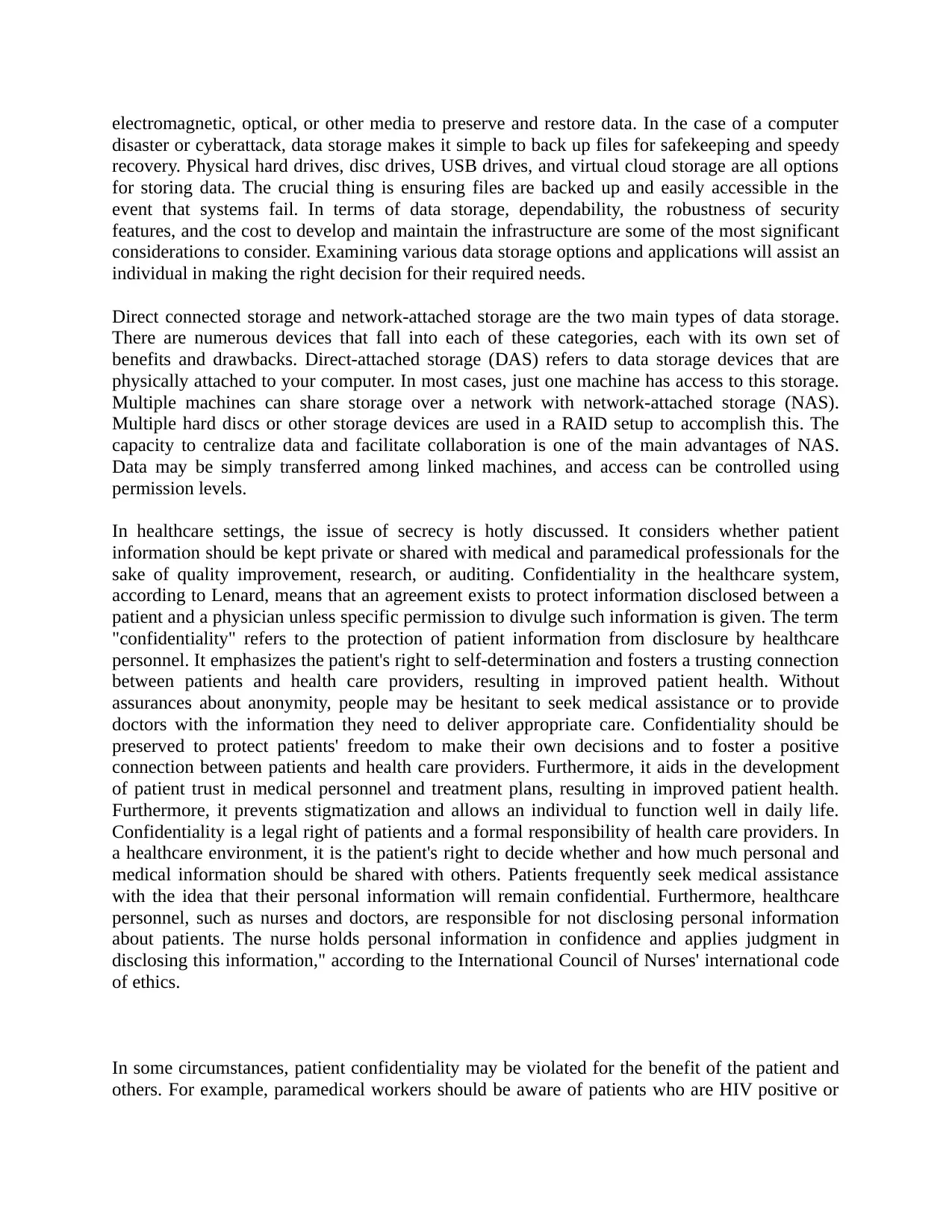
electromagnetic, optical, or other media to preserve and restore data. In the case of a computer
disaster or cyberattack, data storage makes it simple to back up files for safekeeping and speedy
recovery. Physical hard drives, disc drives, USB drives, and virtual cloud storage are all options
for storing data. The crucial thing is ensuring files are backed up and easily accessible in the
event that systems fail. In terms of data storage, dependability, the robustness of security
features, and the cost to develop and maintain the infrastructure are some of the most significant
considerations to consider. Examining various data storage options and applications will assist an
individual in making the right decision for their required needs.
Direct connected storage and network-attached storage are the two main types of data storage.
There are numerous devices that fall into each of these categories, each with its own set of
benefits and drawbacks. Direct-attached storage (DAS) refers to data storage devices that are
physically attached to your computer. In most cases, just one machine has access to this storage.
Multiple machines can share storage over a network with network-attached storage (NAS).
Multiple hard discs or other storage devices are used in a RAID setup to accomplish this. The
capacity to centralize data and facilitate collaboration is one of the main advantages of NAS.
Data may be simply transferred among linked machines, and access can be controlled using
permission levels.
In healthcare settings, the issue of secrecy is hotly discussed. It considers whether patient
information should be kept private or shared with medical and paramedical professionals for the
sake of quality improvement, research, or auditing. Confidentiality in the healthcare system,
according to Lenard, means that an agreement exists to protect information disclosed between a
patient and a physician unless specific permission to divulge such information is given. The term
"confidentiality" refers to the protection of patient information from disclosure by healthcare
personnel. It emphasizes the patient's right to self-determination and fosters a trusting connection
between patients and health care providers, resulting in improved patient health. Without
assurances about anonymity, people may be hesitant to seek medical assistance or to provide
doctors with the information they need to deliver appropriate care. Confidentiality should be
preserved to protect patients' freedom to make their own decisions and to foster a positive
connection between patients and health care providers. Furthermore, it aids in the development
of patient trust in medical personnel and treatment plans, resulting in improved patient health.
Furthermore, it prevents stigmatization and allows an individual to function well in daily life.
Confidentiality is a legal right of patients and a formal responsibility of health care providers. In
a healthcare environment, it is the patient's right to decide whether and how much personal and
medical information should be shared with others. Patients frequently seek medical assistance
with the idea that their personal information will remain confidential. Furthermore, healthcare
personnel, such as nurses and doctors, are responsible for not disclosing personal information
about patients. The nurse holds personal information in confidence and applies judgment in
disclosing this information," according to the International Council of Nurses' international code
of ethics.
In some circumstances, patient confidentiality may be violated for the benefit of the patient and
others. For example, paramedical workers should be aware of patients who are HIV positive or
disaster or cyberattack, data storage makes it simple to back up files for safekeeping and speedy
recovery. Physical hard drives, disc drives, USB drives, and virtual cloud storage are all options
for storing data. The crucial thing is ensuring files are backed up and easily accessible in the
event that systems fail. In terms of data storage, dependability, the robustness of security
features, and the cost to develop and maintain the infrastructure are some of the most significant
considerations to consider. Examining various data storage options and applications will assist an
individual in making the right decision for their required needs.
Direct connected storage and network-attached storage are the two main types of data storage.
There are numerous devices that fall into each of these categories, each with its own set of
benefits and drawbacks. Direct-attached storage (DAS) refers to data storage devices that are
physically attached to your computer. In most cases, just one machine has access to this storage.
Multiple machines can share storage over a network with network-attached storage (NAS).
Multiple hard discs or other storage devices are used in a RAID setup to accomplish this. The
capacity to centralize data and facilitate collaboration is one of the main advantages of NAS.
Data may be simply transferred among linked machines, and access can be controlled using
permission levels.
In healthcare settings, the issue of secrecy is hotly discussed. It considers whether patient
information should be kept private or shared with medical and paramedical professionals for the
sake of quality improvement, research, or auditing. Confidentiality in the healthcare system,
according to Lenard, means that an agreement exists to protect information disclosed between a
patient and a physician unless specific permission to divulge such information is given. The term
"confidentiality" refers to the protection of patient information from disclosure by healthcare
personnel. It emphasizes the patient's right to self-determination and fosters a trusting connection
between patients and health care providers, resulting in improved patient health. Without
assurances about anonymity, people may be hesitant to seek medical assistance or to provide
doctors with the information they need to deliver appropriate care. Confidentiality should be
preserved to protect patients' freedom to make their own decisions and to foster a positive
connection between patients and health care providers. Furthermore, it aids in the development
of patient trust in medical personnel and treatment plans, resulting in improved patient health.
Furthermore, it prevents stigmatization and allows an individual to function well in daily life.
Confidentiality is a legal right of patients and a formal responsibility of health care providers. In
a healthcare environment, it is the patient's right to decide whether and how much personal and
medical information should be shared with others. Patients frequently seek medical assistance
with the idea that their personal information will remain confidential. Furthermore, healthcare
personnel, such as nurses and doctors, are responsible for not disclosing personal information
about patients. The nurse holds personal information in confidence and applies judgment in
disclosing this information," according to the International Council of Nurses' international code
of ethics.
In some circumstances, patient confidentiality may be violated for the benefit of the patient and
others. For example, paramedical workers should be aware of patients who are HIV positive or
⊘ This is a preview!⊘
Do you want full access?
Subscribe today to unlock all pages.

Trusted by 1+ million students worldwide
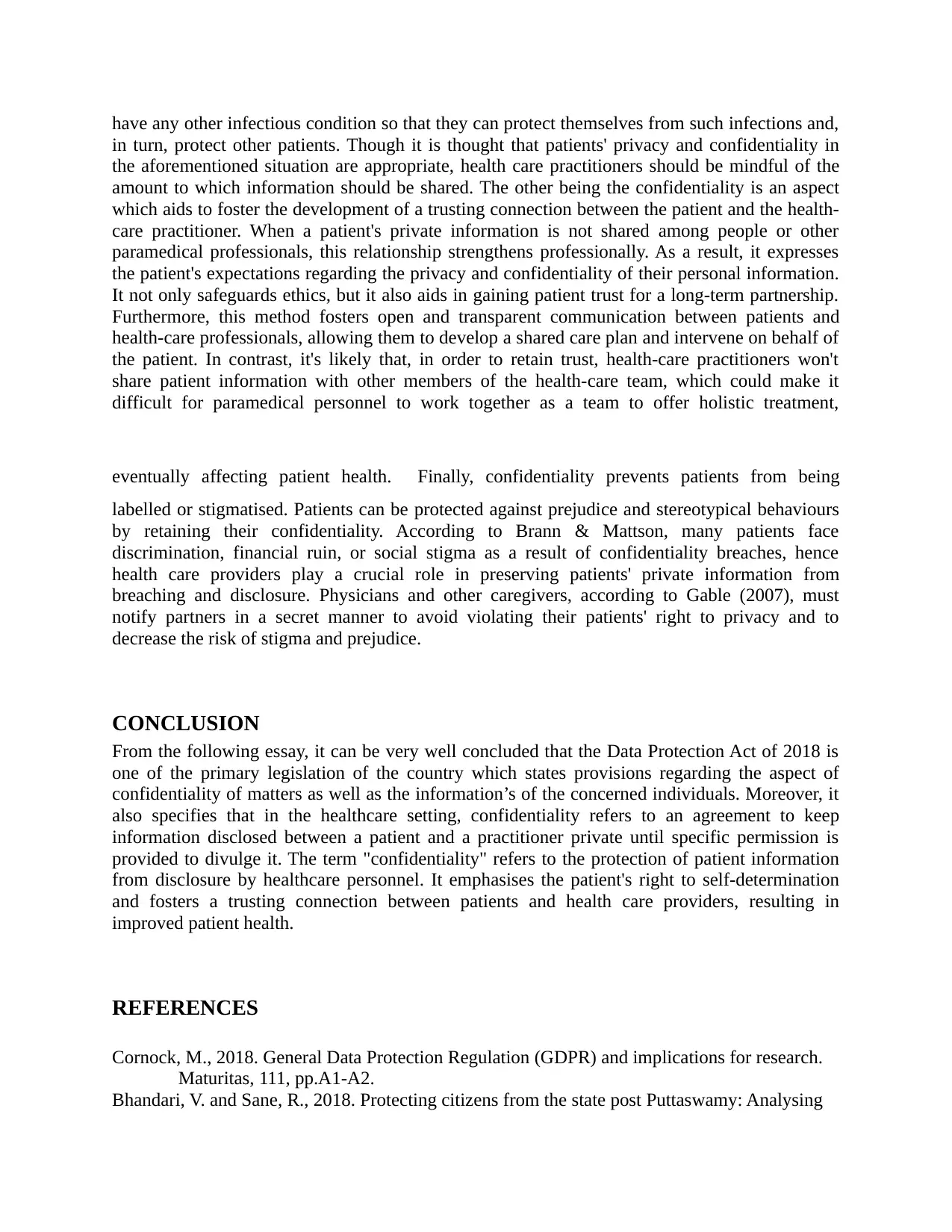
have any other infectious condition so that they can protect themselves from such infections and,
in turn, protect other patients. Though it is thought that patients' privacy and confidentiality in
the aforementioned situation are appropriate, health care practitioners should be mindful of the
amount to which information should be shared. The other being the confidentiality is an aspect
which aids to foster the development of a trusting connection between the patient and the health-
care practitioner. When a patient's private information is not shared among people or other
paramedical professionals, this relationship strengthens professionally. As a result, it expresses
the patient's expectations regarding the privacy and confidentiality of their personal information.
It not only safeguards ethics, but it also aids in gaining patient trust for a long-term partnership.
Furthermore, this method fosters open and transparent communication between patients and
health-care professionals, allowing them to develop a shared care plan and intervene on behalf of
the patient. In contrast, it's likely that, in order to retain trust, health-care practitioners won't
share patient information with other members of the health-care team, which could make it
difficult for paramedical personnel to work together as a team to offer holistic treatment,
eventually affecting patient health. Finally, confidentiality prevents patients from being
labelled or stigmatised. Patients can be protected against prejudice and stereotypical behaviours
by retaining their confidentiality. According to Brann & Mattson, many patients face
discrimination, financial ruin, or social stigma as a result of confidentiality breaches, hence
health care providers play a crucial role in preserving patients' private information from
breaching and disclosure. Physicians and other caregivers, according to Gable (2007), must
notify partners in a secret manner to avoid violating their patients' right to privacy and to
decrease the risk of stigma and prejudice.
CONCLUSION
From the following essay, it can be very well concluded that the Data Protection Act of 2018 is
one of the primary legislation of the country which states provisions regarding the aspect of
confidentiality of matters as well as the information’s of the concerned individuals. Moreover, it
also specifies that in the healthcare setting, confidentiality refers to an agreement to keep
information disclosed between a patient and a practitioner private until specific permission is
provided to divulge it. The term "confidentiality" refers to the protection of patient information
from disclosure by healthcare personnel. It emphasises the patient's right to self-determination
and fosters a trusting connection between patients and health care providers, resulting in
improved patient health.
REFERENCES
Cornock, M., 2018. General Data Protection Regulation (GDPR) and implications for research.
Maturitas, 111, pp.A1-A2.
Bhandari, V. and Sane, R., 2018. Protecting citizens from the state post Puttaswamy: Analysing
in turn, protect other patients. Though it is thought that patients' privacy and confidentiality in
the aforementioned situation are appropriate, health care practitioners should be mindful of the
amount to which information should be shared. The other being the confidentiality is an aspect
which aids to foster the development of a trusting connection between the patient and the health-
care practitioner. When a patient's private information is not shared among people or other
paramedical professionals, this relationship strengthens professionally. As a result, it expresses
the patient's expectations regarding the privacy and confidentiality of their personal information.
It not only safeguards ethics, but it also aids in gaining patient trust for a long-term partnership.
Furthermore, this method fosters open and transparent communication between patients and
health-care professionals, allowing them to develop a shared care plan and intervene on behalf of
the patient. In contrast, it's likely that, in order to retain trust, health-care practitioners won't
share patient information with other members of the health-care team, which could make it
difficult for paramedical personnel to work together as a team to offer holistic treatment,
eventually affecting patient health. Finally, confidentiality prevents patients from being
labelled or stigmatised. Patients can be protected against prejudice and stereotypical behaviours
by retaining their confidentiality. According to Brann & Mattson, many patients face
discrimination, financial ruin, or social stigma as a result of confidentiality breaches, hence
health care providers play a crucial role in preserving patients' private information from
breaching and disclosure. Physicians and other caregivers, according to Gable (2007), must
notify partners in a secret manner to avoid violating their patients' right to privacy and to
decrease the risk of stigma and prejudice.
CONCLUSION
From the following essay, it can be very well concluded that the Data Protection Act of 2018 is
one of the primary legislation of the country which states provisions regarding the aspect of
confidentiality of matters as well as the information’s of the concerned individuals. Moreover, it
also specifies that in the healthcare setting, confidentiality refers to an agreement to keep
information disclosed between a patient and a practitioner private until specific permission is
provided to divulge it. The term "confidentiality" refers to the protection of patient information
from disclosure by healthcare personnel. It emphasises the patient's right to self-determination
and fosters a trusting connection between patients and health care providers, resulting in
improved patient health.
REFERENCES
Cornock, M., 2018. General Data Protection Regulation (GDPR) and implications for research.
Maturitas, 111, pp.A1-A2.
Bhandari, V. and Sane, R., 2018. Protecting citizens from the state post Puttaswamy: Analysing
Paraphrase This Document
Need a fresh take? Get an instant paraphrase of this document with our AI Paraphraser
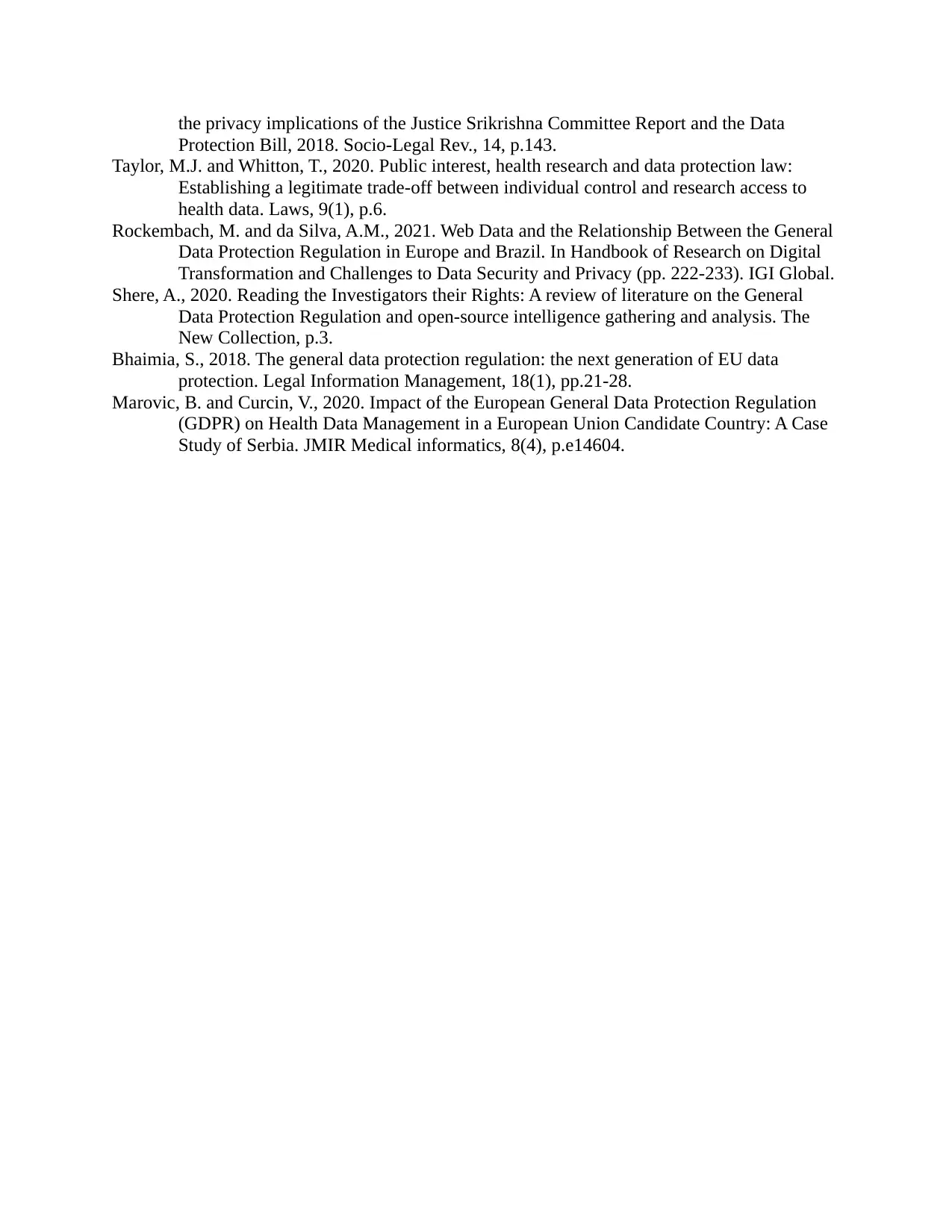
the privacy implications of the Justice Srikrishna Committee Report and the Data
Protection Bill, 2018. Socio-Legal Rev., 14, p.143.
Taylor, M.J. and Whitton, T., 2020. Public interest, health research and data protection law:
Establishing a legitimate trade-off between individual control and research access to
health data. Laws, 9(1), p.6.
Rockembach, M. and da Silva, A.M., 2021. Web Data and the Relationship Between the General
Data Protection Regulation in Europe and Brazil. In Handbook of Research on Digital
Transformation and Challenges to Data Security and Privacy (pp. 222-233). IGI Global.
Shere, A., 2020. Reading the Investigators their Rights: A review of literature on the General
Data Protection Regulation and open-source intelligence gathering and analysis. The
New Collection, p.3.
Bhaimia, S., 2018. The general data protection regulation: the next generation of EU data
protection. Legal Information Management, 18(1), pp.21-28.
Marovic, B. and Curcin, V., 2020. Impact of the European General Data Protection Regulation
(GDPR) on Health Data Management in a European Union Candidate Country: A Case
Study of Serbia. JMIR Medical informatics, 8(4), p.e14604.
Protection Bill, 2018. Socio-Legal Rev., 14, p.143.
Taylor, M.J. and Whitton, T., 2020. Public interest, health research and data protection law:
Establishing a legitimate trade-off between individual control and research access to
health data. Laws, 9(1), p.6.
Rockembach, M. and da Silva, A.M., 2021. Web Data and the Relationship Between the General
Data Protection Regulation in Europe and Brazil. In Handbook of Research on Digital
Transformation and Challenges to Data Security and Privacy (pp. 222-233). IGI Global.
Shere, A., 2020. Reading the Investigators their Rights: A review of literature on the General
Data Protection Regulation and open-source intelligence gathering and analysis. The
New Collection, p.3.
Bhaimia, S., 2018. The general data protection regulation: the next generation of EU data
protection. Legal Information Management, 18(1), pp.21-28.
Marovic, B. and Curcin, V., 2020. Impact of the European General Data Protection Regulation
(GDPR) on Health Data Management in a European Union Candidate Country: A Case
Study of Serbia. JMIR Medical informatics, 8(4), p.e14604.
1 out of 5
Related Documents
Your All-in-One AI-Powered Toolkit for Academic Success.
+13062052269
info@desklib.com
Available 24*7 on WhatsApp / Email
![[object Object]](/_next/static/media/star-bottom.7253800d.svg)
Unlock your academic potential
Copyright © 2020–2025 A2Z Services. All Rights Reserved. Developed and managed by ZUCOL.





